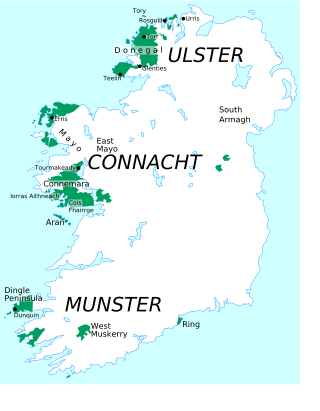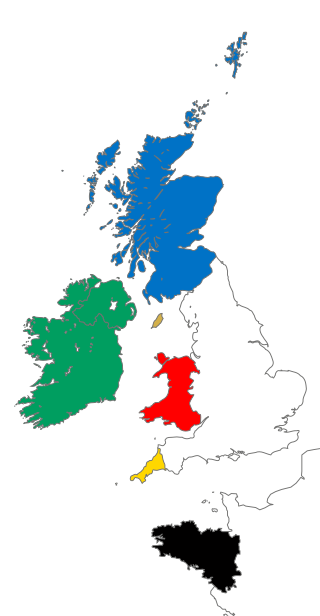Early retellings
Prior to the translation of the Bible into Irish, retelling parts of the story was more common. One example of this is the tenth-century Saltair na Rann , an account of the Creation and the lives of Adam and Eve. [1]

Translations of the Bible into Irish were first printed and published in the 17th century: the New Testament, the Tiomna Nuadh, in 1602, the Old Testament, the Sean Thiomna, in 1685, and the entire Bible, the Biobla (Old and New Testaments combined) in 1690.
Prior to the translation of the Bible into Irish, retelling parts of the story was more common. One example of this is the tenth-century Saltair na Rann , an account of the Creation and the lives of Adam and Eve. [1]

After the Tudor reconquest of Ireland, the established Church of Ireland attempted to consolidate the Reformation in Ireland, with little success among the Gaelic Irish. The first translation of the New Testament (Tiomna Nuadh) was begun by Nicholas Walsh, Bishop of Ossory, who worked on it until his untimely death in 1585. The work was continued by John Kearney (Treasurer of St. Patrick's, Dublin), his assistant, and Dr. Nehemiah Donellan, Archbishop of Tuam, and it was finally completed by William O'Domhnuill (William Daniel, Archbishop of Tuam in succession to Donellan). The Irish New Testament was printed in 1602 and was reprinted in 1681. [2] The entire Bible (Old and New Testaments combined) was first published in 1690.
The work of translating the Old Testament was undertaken by William Bedell (1571–1642), Bishop of Kilmore, who completed his translation within the reign of Charles I. [3] [4] However, the Old Testament was not published in Irish until 1685, in a revised version by Narcissus Marsh (1638–1713), Archbishop of Dublin. [5] [6]
In 1817 the British and Foreign Bible Society published an edition of ‘An Biobla Naomhta’. [7] It was printed in London in Roman typeface, and included the Bedell Old Testament and the O’Donnell New Testament. It is sometimes called the Bedel or Bedell version.
| Translation | John (Eoin) 3:16 |
|---|---|
| An Bíobla Naomhtha (Bedel version, from reprint in 1817) | Oír is mar so do ghrádhuigh Día an domhan, go dtug sé a éinghein Meic fein, ionnus gidh bé chreideas ann, nach rachadh sé a mugha, achd go mbeith an bheatha shiorruidhe aige. (In today's form: Óir is mar seo do ghráigh Dia an domhan, go dtug sé a aonghin Mic féin, ionas gibé chreideas ann, nach rachadh sé amú, ach go mbeadh an bheatha shíoraí aige.) |

Peadar Ua Laoghaire (Peter O’Leary) was a Catholic priest and great scholar. He was born in 1839 and died in March 1920. He spoke Munster Irish and wrote much literature in the Irish language. He translated the whole Bible and some of it was published by Brún agus Ó Nóláin. The 4 Gospels were published in 1915, Acts in 1921. He translated the New Testament from the Vulgate with reference to the Greek, and translated the Old Testament from the Septuagint. The unpublished manuscripts are at Maynooth University.
In 1951, the Hibernian Bible Society published a translation of the New Testament into Irish made by Earnán De Siúnta (Ernest Edwin Joynt, "An Buachaillín Buidhe") a Methodist active in the Gaelic League, and based on the 1602 translation. [8]
An Scrioptúir Naoṁṫa - na ceiṫre soiscéil agus gníoṁarṫa na n-Abstal (The Holy Scriptures - The 4 Gospels and Acts of the Apostles) was first translated into Irish Gaelic by Pádraig Mac Giolla Cheara. It was published in 1943 by Comhaltas Uladh of Belfast and Dundalk. It got the Imprimatur from Cardinal Joseph MacRory, Archbishop of Armagh, Primate of All Ireland. He later produced a second edition of the Acts of the Apostles rendered into the revised modern Irish grammar and spelling in 1961.
In 1970 the New Testament (Tiomna Nua) was translated by Church of Ireland minister Cosslett Ó Cuinn (1907-1995), after he took up the post of professor of Biblical Greek at Trinity College, Dublin in 1961. It is based on the Revised Standard Version (RSV) in English and the original Greek. It has a distinct Ulster dialect. It was published in 1970 by Cumann Gaelach na hEaglaise (Irish Guild of the Church of Ireland) with the assistance of the Hibernian Bible Society (now called the National Bible Society of Ireland). He also translated the Book of Psalms which is in the Church of Ireland Book of Common Prayer, [9] published in 1965.
The Irish Roman Catholic bishops established a commission in 1945 to plan the publication of an Irish-language New Testament, and a steering committee in 1966 to publish a complete Bible. [10] Books were published individually in various forms by An Sagart, a Catholic publisher established at Saint Patrick's College, Maynooth by Pádraig Ó Fiannachta, from the Gospel of Luke in 1964 until 1977. [10] [11] Ó Fiannachta and Coslett Ó Cuinn were among the translators. [10] A complete version, revised from the originals and edited by Ó Fiannachta, was published as An Bíobla Naofa in 1981. [10] This is now available online. [12] In 2014 an edition of the New Testament and Psalms was published with revised proper names.
| Translation | John (Eoin) 3:16 |
|---|---|
| An Bíobla Naofa (The Holy Bible, 1981 Catholic translation) | Óir ghráigh Dia an domhan chomh mór sin gur thug sé a Aonghin Mic uaidh i dtreo, gach duine a chreideann ann, nach gcaillfí é ach go mbeadh an bheatha shíoraí aige. |

The Flight of the Earls took place in September 1607, when Hugh O'Neill, 2nd Earl of Tyrone, and Rory O'Donnell, 1st Earl of Tyrconnell, and about ninety followers, left Ulster in Ireland for mainland Europe. Their permanent exile was a watershed event in Irish history, symbolizing the end of the old Gaelic order.

Munster Irish is the dialect of the Irish language spoken in the province of Munster. Gaeltacht regions in Munster are found in the Gaeltachtaí of the Dingle Peninsula in west County Kerry, in the Iveragh Peninsula in south Kerry, in Cape Clear Island off the coast of west County Cork, in Muskerry West; Cúil Aodha, Ballingeary, Ballyvourney, Kilnamartyra, and Renaree of central County Cork; and in an Rinn and an Sean Phobal in Gaeltacht na nDéise in west County Waterford.
Nollaig Ó Muraíle is an Irish scholar. He published an acclaimed edition of Dubhaltach Mac Fhirbhisigh's Leabhar na nGenealach in 2004. He was admitted to the Royal Irish Academy in 2009.

Early Modern Irish represented a transition between Middle Irish and Modern Irish. Its literary form, Classical Gaelic, was used in Ireland and Scotland from the 13th to the 18th century.
Events from the year 1690 in the Kingdom of Scotland.
Pádraig Ó Fiannachta was an Irish-language scholar, poet and priest from the Kerry Gaeltacht. He is perhaps best known for producing a translation of the Christian Bible into the Irish language.
Irish genealogy is the study of individuals and families who originated on the island of Ireland.
Nehemiah Donnellan was Archbishop of Tuam.
William Daniel D.D. was an Irish clergyman who served as the Church of Ireland Archbishop of Tuam from 1609 until his death in 1628.
Murtagh King was an Irish Old Testament translator and scribe.
The Rev. Canon Cosslett Quin, in Irish Cosslett Ó Cuinn was a priest of the Church of Ireland who translated the New Testament into Irish.
Triallam timcheall na Fodla is medieval Irish-language poetic manuscript about topography.
Tuilleadh feasa ar Éirinn óigh is a medieval Gaelic-Irish topographical text, composed by Giolla na Naomh Ó hUidhrín.
The New Testament was first published in Scottish Gaelic in 1767 and the whole Bible was first published in 1801. Prior to these, Gaels in Scotland had used translations into Irish.
Seosamh Laoide, known as "Mac Tíre na Páirce", was an Irish language scholar and activist during the period 1893 – 1915. Today he is perhaps best remembered for his work on Irish placenames, particularly on the placenames of Dublin, with his proposals often becoming the established Irish versions for the city's streets following the establishment of the Irish state in December 1922.

In addition to English, literature has been written in a wide variety of other languages in Britain, that is the United Kingdom, the Isle of Man and the Channel Islands. This includes literature in Scottish Gaelic, Welsh, Latin, Cornish, Anglo-Norman, Guernésiais, Jèrriais, Manx, and Irish. Literature in Anglo-Saxon is treated as English literature and literature in Scots as Scottish literature.

Coláiste na hÉireann is a third-level college in Dublin, Ireland offering qualifications in the study of translation and the Irish language.
Máirín Ní Mhuiríosa was an Irish scholar, poet and journalist.
Lil Nic Dhonnchadha was an Irish language scholar and language activist.
Risteárd Ó Glaisne was a Methodist Irish language activist, teacher and writer.